|
|
Updated as per James P. Tuttle's The Hawk Moths of North America, September 16, 2008
|
Hunterdon County, New Jersey
Sphingidae
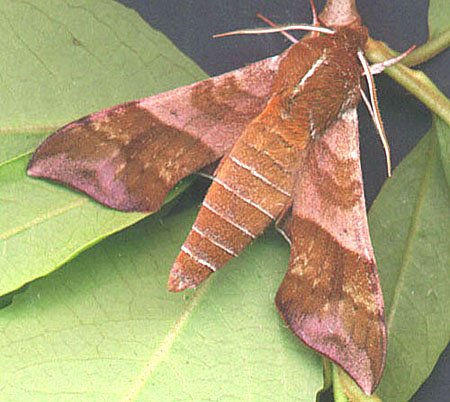
Darapsa pholus (now Darapsa choerilus)
by Bill Oehlke.
This site has been created by
Bill Oehlke.
Comments, suggestions and/or additional information/sightings are welcomed by Bill.
I spent my teen years in Pottersville, New Jersey. I was on the Hunterdon County side of the Black River. Just across the river was
Morris County, and about half a mile upstream one could enter Warren County.
My father was primarily interested in Saturniidae and we had a large blacklight mounted above a sheet on the river side of the house.
While Dad was doing the silkmoths, I took an interest in the Sphingidae and studied Holland's Moth Book, trying to identify
the moths that would arrive at the light.
I still (2005) have a shadow box display of nine species (Lintneria eremitus, Sphinx gordius, Paonias myops, Smerinthus
jamaicensis, Darapsa choerilus, Darapsa myron, Hyles lineata, Sphecodina abbottii and Xylophanes tersa) that I captured
and spread in Pottersville in the early 1960s.
I can also remember the large Manduca quinquemaculatus and Manduca sexta that were attracted to the light.
My grandfather's tomato plants were often savaged by the larvae.
Some evenings large numbers of Eumorpha pandorus would arrive
almost simultaneously, and Paonias excaecata were also common.
During the day, Hemaris thysbe could be seen nectaring at my
mother's butterfly bush and the other flowers in her garden.
My first attempt at rearing Sphingidae from eggs involved
Amorpha juglandis, from a female taken at the same light.
Forty-six Sphingidae species are listed for New Jersey on the U.S.G.S. website (now BAMONA). Not all of the species are reported or anticipated in
Hunterdon County (ten are reported on U.S.G.S.). It is hoped that this checklist, with the thumbnails and notes, will help you
quickly identify the moths you are likely to encounter.
A "WO" after the species name indicates that I have either observed this moth myself in Hunterdon County,
or I (William Oehlke) expect that this moth is present or might be present.
A "USGS" indicates the moth is reported on the USGS website and/or in
Lepidoptera of North America, #1. Distribution of Silkmoths (Saturniidae) and Hawkmoths (Sphingidae)
of Eastern North America, an excellent little booklet available through Paul Opler.
Please help me develop this list with improved, documented accuracy by sending sightings (species, date, location), preferably with an
electronic image, via email to Bill Oehlke.
Many thanks to Karen Simister who provide the Ceratomia undulosa image below.
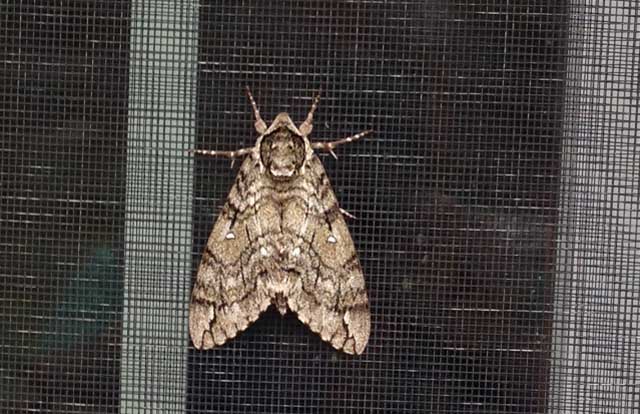
Ceratomia undulosa, Hunterdon County, New Jersey,
August 12, 2017, courtesy of Karen Simister.
Visit Hunterdon County Sphingidae Larvae: Caterpillars; Hornworms
Visit New Jersey Catocala: Underwing Moths
If you are travelling, you can find active Sphingidae checklists for all countries in North, Central, and South America and the Caribbbean via the links at
North, Central, South American Sphingidae checklists
Sphinginae subfamily
Sphingini tribe:
 |
Ceratomia amyntor WO,
the Elm Sphinx or Four-horned Sphinx.
This moth is not officially recorded in Hunterdon, but I suspect it is present.
Larvae feed on Elm (Ulmus), birch (Betula), basswood (Tilia), and
cherry (Prunus).
|
 |
Ceratomia catalpae
WO,
the Catalpa Sphinx.
This species is not officially recorded for Hunterdon.
I have seen them in great numbers in other New Jersey counties. The larvae feed in large groups and are much more
spectacular than the moths. Catalpa is the larval host.
|
 |
Ceratomia undulosa
WO/USGS, the Waved
Sphinx.
This moth is recorded in Hunterdon. I have seen them as far north as
P.E.I. in eastern Canada, and took them in New Jersey.
It is
named for the wavy lines on the forewings.
|
Ceratomia undulosa, August 12, 2017, Karen Simister

|
Dolba hyloeus
USGS, the Pawpaw Sphinx.
This moth is recorded in Hunterdon. It is widely reported in
other New Jersey counties and in Connecticut.
|
 |
Lapara bombycoides
WO, the
Northern Pine Sphinx.
This moth is not reported from Hunterdon County, but if you have pines, you
probably have this species. It flies on P.E.I.
|
 |
Lapara coniferarum
WO, the Southern Pine Sphinx.
This moth is not reported from Hunterdon County, but it is widely
reported in New Jersey and along the coast in Connecticut and Masachusetts.
If you've got pines, this species is likely present.
|
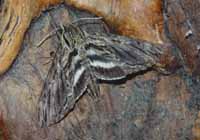 | This species is confirmed for Hunterdon by Bill Oehlke.
Generally it is not widely reported.
Larval hosts are various species of beebalm (Monarda), mints (Mentha), bugleweed (Lycopis),
and sage (Salvia). |
 |
Manduca jasminearum
USGS, the Ash Sphinx.
This species is officially recorded in Hunterdon County.
It is reported in New Jersey, southeastern New York and Connecticut.
|
 |
Manduca quinquemaculatus
WO,
the Five-spotted Hawkmoth.
This species is has been recorded by Bill Oehlke in Hunterdon, and
has been seen in nearby counties.
I suspect if you grow tomatoes, you are likely to encounter it.
|
 |
Manduca rustica
WO, the Rustic Sphinx.
This species is not officially recorded in Hunterdon, but it has been
taken in other counties in northeastern and central eastern New Jersey. I would not
be surprised to get a report. Look for three large yellow spots
on each side of the abdomen.
|
 |
Manduca sexta
WO, the Carolina Sphinx.
This species is recorded in Hunterdon by Bill Oehlke.
If you grow tomatoes, you have probably encountered it, though.
Larvae get very large and can strip a tomato plant.
|
 |
Paratrea plebeja
WO, the Plebeian Sphinx.
The upperside of the forewing is gray with indistinct black and
white markings. There is a series of black dashes
from the base to the tip, and a small white cell spot.Questionable
|
 |
Sphinx chersis USGS,
the Northern Ash Sphinx or Great Ash Sphinx.
This species is reported in Hunterdon. Larval hosts are ash,
lilac, privet, cherry, and quaking aspen.
|
 | This species is not officially reported in Hunterdon. We have them
on P.E.I., but I do not see them nearly as frequently
as I see the other Sphingidae.
|
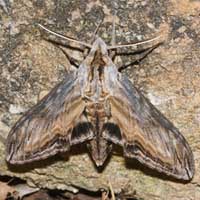 | This species is reported in Hunterdon. Generally it is
not widely reported anywhere.
Similar to S. kalmiae but lacks the dark bar
along the fw inner margin.
|
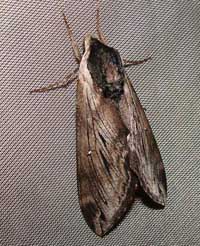 |
Sphinx gordius
WO, the
Apple Sphinx. This species is confirmed in Hunterdon by Bill Oehlke.
It is widely reported in neighbouring counties.
Note the pm line, absent in Sphinx poecila which flies
more to the north.
The terminal area, especially near the anal angle, is much darker than
in S. poecila.
|
 |
This species is not officially reported in Hunterdon.
I have taken them on P.E.I., Canada, and reared them on
lilac. At rest the hindwings are usually completely covered.
|
Smerinthini Tribe:
 |
Amorpha juglandis
WO,
the Walnut Sphinx.
This moth is fairly widely reported to the north and east
and I have taken them in Hunterdon.
This is the first Sphinx species I reared as a boy in New Jersey.
See the file for the female; she is different.
|
 |
Pachysphinx modesta
WO,
the Modest Sphinx or Poplar Sphinx.
This moth is not officially recorded in Hunterdon County. It is fond
of poplars and willows.
They are common on Prince Edward Island.
|
 |
Paonias astylus
WO, the Huckleberry Sphinx.
This appears to be an uncommon species. They are not officially
recorded for Hunterdon.
|
 |
Paonias excaecata WO,
the Blinded Sphinx.
Named for the dull grey-blue spot (minus dark pupil) in the hindwing,
this moth has a wide distribution and is common in Hunterdon
County.
I regularly see them on Prince Edward Island, and they are reported
as far south as Florida.
|
 |
Paonias myops WO, the Small-eyed Sphinx.
Named for the small eye-spot in the hindwing, this moth has a wide distribution
and is common in Hunterdon County.
I regularly see them on Prince Edward Island, and they are reported
as far south as Florida.
|
 |
Smerinthus jamaicensis
WO,
the Twin-spotted Sphinx.
This moth is widely distributed and fairly common.
Along the East Coast, it flies from P.E.I. to Florida.
|
Macroglossinae subfamily
Dilophonotini tribe:
 |
Hemaris thysbe
WO, the Hummingbird Clearwing.
This interesting day flier is copnfirmed in Hunterdon and
is widely reported to the north, east and west.
They are widely distributed in the east from P.E.I. to Florida.
|
 |
Hemaris diffinis
USGS, the
Snowberry Clearwing or Bumblebee Moth.
This moth is widespread and has been officially recorded in
Hunterdon. It has been confirmed in northwestern N.J. and
southeastern N.Y. and Connecticut.
|
 |
Hemaris gracilis WO, the
Slender Clearwing or Graceful Clearwing.
This day-flying moth is less common and has not been recorded in
Hunterdon, but has been seen in northeastern N.J. and
southeastern N.Y.
|
Philampelini tribe:
 |
Eumorpha achemon
USGS,
the Achemon Sphinx.
This moth is officially reported for Hunterdon, and
it is fairly often reported
along the coast from southern New Jersey
to central Maine.
Note the differences between this moth and the Pandorus Sphinx.
|
 |
Eumorpha pandorus
USGS/ WO, the Pandorus Sphinx.
If you have Grape or Virginia Creeper nearby, then you probably have
this species. I have often seen them in Pottersville.
|
Macroglossini tribe:
 |
This day flier is widely distributed. If you have Virginia Creeper, you
probably have the Nessus Sphinx. It is reported from
Hunterdon.
Two bright, distinct, narrow yellow
bands are often visible on the abdomen.
|
 |
They are common in New Jersey and common
here on Prince Edward Island.
You will often see this species listed as Darapsa pholus,
especially in older literature.
They are common
in Hunterdon County.
|
 |
Darapsa myron
WO, Virginia Creeper Sphinx, Grapevine Sphinx.
Not recorded on the U.S.G.S. site for Hunterdon County,
but I can confirm its presence.
It is widely reported as far north as southern Maine. If you have the
foodplants indicated in the common names, you probably have this
species nearby.
|
 |
Darapsa versicolor
WO,
Hydrangea Sphinx.
If you have hydrangea growing near a stream, then you may have the
Hydrangea Sphinx.
It has not been reported in Hunterdon County,
but I suspect it is present, but probably uncommon.
|
 |
Deidamia inscriptum
USGS,
the Lettered Sphinx.
This species has been officially recorded in Hunterdon.
Grape (Vitis), ampelopsis (Ampelopsis), and Virginia creeper (Parthenocissus) all serve as larval hosts. |
 |
Hyles lineata
WO, the White-lined Sphinx.
This species has been taken in Pottersville. It has
strong migrating tendancies from much further south.
There are records from New Hampshire and Maine. |
 |
Sphecodina abbottii
WO,
the Abbott's Sphinx.
This moth is very much under reported across the United States. It
is a rapid day flier so is probably not in too many collections.
Grape is a popular larval host. I have taken it is Pottersville.
|
 |
Xylophanes tersa WO,
the Tersa Sphinx.
This moth is much more common to the south. It is a strong migrant,
however. I have taken a specimen in Hunterdon County.
|
|
|
Enjoy some of nature's wonderments, giant silk moth cocoons.
These cocoons are for sale winter and fall. Beautiful Saturniidae moths will emerge the following spring and summer.
Read Actias luna rearing article. Additional online help available.
Use your browser "Back" button to return to the previous page.
This page is brought to you by Bill Oehlke and the
WLSS. Pages are on space rented from Bizland. If you would like
to become a "Patron of the Sphingidae Site", contact Bill.
Please send sightings/images to Bill. I will do my best to respond to
requests for identification help.
 | 
Show appreciation for this site by clicking on flashing butterfly to the left.
The link will take you to a page with links to many insect sites. |
This website has been created and is maintained by Bill Oehlke without government or institutional financial assistance. All expenses, ie., text reference
support material, webspace rental from Bizland, computer repairs/replacements, backups systems, software for image adjustments (Adobe Photoshop; L-View),
ftp software, anti-virus protection, scanner, etc. are my own.
I very much appreciate all the many images that have been sent to me, or of which I have been granted permission to copy and post from other websites.
All images on this site remain the property of respective photographers.
If you would like to contribute to the maintenace of this website by sending a contribution to
Bill Oehlke
Box 476
155 Peardon Road
Montague, Prince Edward Island, C0A1R0
Canada
your donation would be much appreciated and would be used for
1) paying for webspace rental;
2) paying for computer maintenance and software upgrades;
3) purchases of additional text reference material (journals and books) in anticipation of expanding the site to a worldwide Sphingidae site;
4) helping to pay my daughter's tuition (completed spring 2013); with anything left over going to humanitarian aid.
If you are mailing a check from USA, please use $0.85 postage. ($1.15 is 2017 rate so check with post office as rates seem to be rising almost annually.)
Donations can also be made through Paypal via the button below.



